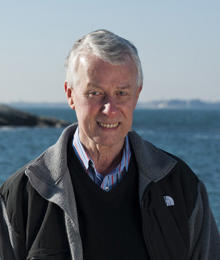An interview with Sir Richard Roberts FRS
Sir Richard Roberts FRS is Chief Scientific Officer at New England Biolabs and a Nobel Laureate. In this interview, he tells us more about his research on restriction enzymes and DNA sequencing; where his interest in microbiology stemmed from, and why he thinks microbiology matters.

Tell us about your current research.
My current research is focused on identifying DNA methyltransferases and their recognition sequences in bacteria. It seems that many have functions quite distinct from protecting against restriction enzymes and some may be useful targets for antibiotics.
In 1993 you were awarded the Nobel Prize in Physiology or Medicine for your contribution to the discovery of introns in eukaryotic DNA and the mechanism of gene-splicing. Can you tell us more about how this discovery has revolutionized science?
Prior to 1977, it was universally believed that genes in eukaryotes were more or less identical to those in bacteria, which have been reasonably well characterised. However, our discovery that they were actually separated into introns and exons, and that mRNA was produced by a process of transcription and then cutting and splicing, completely changed our understanding of eukaryotic biology. This meant that our ability to interpret the DNA sequence of eukaryotes required an intimate knowledge of this splicing mechanism and required a lot more than just reading the DNA sequence three bases at a time to determine the sequence of the protein it encoded.
Where did your interest in microbiology come from?
As a post-doc at Harvard, I was given a project to sequence a tRNA that was involved in bacterial cell wall synthesis. I then learned RNA sequencing in Fred Sanger’s lab and became the first person in the Boston area to be using Fred’s new methods. While at Harvard I heard Professor Dan Nathan's talk about how the first restriction enzyme could be used to make specific fragments of DNA, and when I went to Cold Spring Harbor for my first real job, I was determined to see if there were more restriction enzymes; with a view to use them to develop DNA sequencing methods. However, the restriction enzymes themselves were so useful and prolific that my research focused on characterising as many as possible for use in molecular biology. This, of course, formed the foundation upon which the biotechnology industry was built. Since all these enzymes came from microbial sources, I became fascinated with the bacteria themselves and now I often give a talk entitled “Why I love bacteria”.
What is a typical working day for you?
I usually get up by 6 or 7am, check emails, have a light breakfast and head into the lab. I work steadily, with short breaks for lunch and dinner until midnight or 1am. Because almost everything I do involves bioinformatics I am able to work while I travel. However, I don’t consider it work, just fun.
Why does microbiology matter?
Among other things, the microbes in our body are essential for life. We don’t yet understand very much about how they work and interact both with themselves and the cells in our body, including our brain. I believe they have a great future role to play in the future of medicine. In addition, they can serve as factories to produce chemicals, enzymes and metabolites that have many uses in industry, as well as in health. But best of all, they are relatively simple by comparison with most life forms, and it is my hope that before I die, we will learn how at least a simple bacterium works. That is to say we will be able to write a computer program that can behave exactly as a bacterium would.


